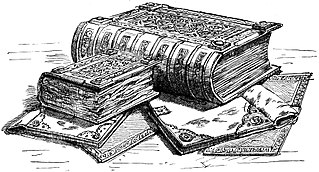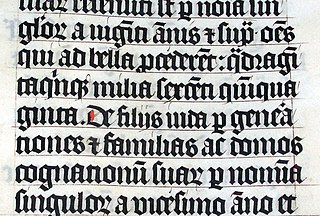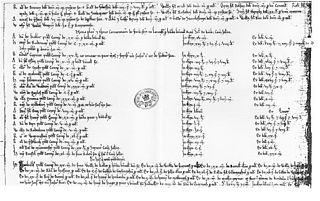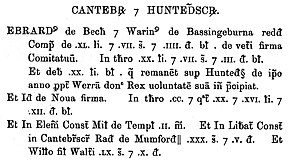
Typography is the art and technique of arranging type to make written language legible, readable and appealing when displayed. The arrangement of type involves selecting typefaces, point sizes, line lengths, line-spacing (leading), and letter-spacing (tracking), as well as adjusting the space between pairs of letters (kerning). The term typography is also applied to the style, arrangement, and appearance of the letters, numbers, and symbols created by the process. Type design is a closely related craft, sometimes considered part of typography; most typographers do not design typefaces, and some type designers do not consider themselves typographers. Typography also may be used as an ornamental and decorative device, unrelated to the communication of information.

Domesday Book – the Middle English spelling of "Doomsday Book" – is a manuscript record of the "Great Survey" of much of England and parts of Wales completed in 1086 by order of King William I, known as William the Conqueror. The manuscript was originally known by the Latin name Liber de Wintonia, meaning "Book of Winchester", where it was originally kept in the royal treasury. The Anglo-Saxon Chronicle states that in 1085 the king sent his agents to survey every shire in England, to list his holdings and dues owed to him.

The long s ⟨ſ⟩, also known as the medial s or initial s, is an archaic form of the lowercase letter ⟨s⟩. It replaced the single s, or one or both of the letters s in a 'double s' sequence. The modern ⟨s⟩ letterform is known as the 'short', 'terminal', or 'round' s. In typography, it is known as a type of swash letter, commonly referred to as a "swash s". The long s is the basis of the first half of the grapheme of the German alphabet ligature letter ⟨ß⟩,.

John Nichols was an English printer, author and antiquary. He is remembered as an influential editor of the Gentleman's Magazine for nearly 40 years; author of a monumental county history of Leicestershire; author of two compendia of biographical material relating to his literary contemporaries; and as one of the agents behind the first complete publication of Domesday Book in 1783.
Diplomatics, or diplomatic, is a scholarly discipline centred on the critical analysis of documents: especially, historical documents. It focuses on the conventions, protocols and formulae that have been used by document creators, and uses these to increase understanding of the processes of document creation, of information transmission, and of the relationships between the facts which the documents purport to record and reality.

Scribal abbreviations or sigla are abbreviations used by ancient and medieval scribes writing in various languages, including Latin, Greek, Old English and Old Norse.

Stanley Arthur Morison was a British typographer, printing executive and historian of printing. Largely self-educated, he promoted higher standards in printing and an awareness of the best printing and typefaces of the past.

The Complutensian Polyglot Bible is the name given to the first printed polyglot of the entire Bible. The edition was initiated and financed by Cardinal Francisco Jiménez de Cisneros (1436–1517) and published by Complutense University in Alcalá de Henares, Spain. It includes the first printed editions of the Greek New Testament, the complete Septuagint, and the Targum Onkelos. Of the 600 six-volume sets which were printed, only 123 are known to have survived to date.

The Pipe rolls, sometimes called the Great rolls, or the Great Rolls of the Pipe are a collection of financial records maintained by the English Exchequer, or Treasury, and its successors. The earliest date from the 12th century, and the series extends, mostly complete, from then until 1833. They form the oldest continuous series of records concerning English governance kept by the English, British and United Kingdom governments, covering a span of about 700 years. The early medieval ones are especially useful for historical study, as they are some of the earliest financial records available from the Middle Ages. A similar set of records was developed for Normandy, which was ruled by the English kings from 1066 to 1205, but the Norman Pipe rolls have not survived in a continuous series like the English.

The Selden Society is a learned society and registered charity concerned with the study of English legal history. It functions primarily as a text publication society, but also undertakes other activities to promote scholarship within its sphere of interest. It is the only learned society wholly devoted to the topic of English legal history.

Modern typographers view typography as a craft with a very long history tracing its origins back to the first punches and dies used to make seals and coinage currency in ancient times. The basic elements of typography are at least as old as civilization and the earliest writing systems—a series of key developments that were eventually drawn together into one systematic craft. While woodblock printing and movable type had precedents in East Asia, typography in the Western world developed after the invention of the printing press by Johannes Gutenberg in the mid-15th century. The initial spread of printing throughout Germany and Italy led to the enduring legacy and continued use of blackletter, roman, and italic types.

A text publication society is a learned society which publishes scholarly editions of old works of historical or literary interest, or archival documents. In addition to full texts, a text publication society may publish translations, calendars and indexes.
The patent rolls are a series of administrative records compiled in the English, British and United Kingdom Chancery, running from 1201 to the present day.

The Codex Laud, or Laudianus, is a sixteenth-century Mesoamerican codex named for William Laud, an English archbishop who was the former owner. It is from the Borgia Group, and is a pictorial manuscript consisting of 24 leaves from Central Mexico, dating from before the Spanish takeover. It is evidently incomplete.
A charter roll is an administrative record created by a medieval chancery that recorded all the charters issued by that office.
The text of Domesday Book, the record of the great survey of England completed in 1086 executed for William I of England, was first edited by Abraham Farley in the 1770s. The first facsimile edition of the manuscripts was made in a project led by the cartographer Henry James in the 1860s. An English translation of the Latin text for most counties was published by the Victoria County History (VCH) during much of the 20th century.
Abraham Farley (?1712–1791) was an English chamberlain who was custodian of the Domesday Book. He was appointed Deputy Chamberlain of the Exchequer in 1736 and became responsible for the public records at the Chapter House of Westminster Abbey. First amongst these was the Domesday Book, of which Farley became custodian, granting visiting antiquaries access to make transcripts for a fee. In 1753, he was approached by Philip Carteret Webb to make a transcript from Domesday Book; this he did, and, perhaps in return for Webb’s help in raising awareness of Domesday’s importance, waived the usual fee. Two years later, Webb’s paper on the Book was read to the Society of Antiquaries of London. In later life, Farley was to produce the first printed edition of the Domesday Book, which was then in high demand. Following a Parliamentary order in 1767, Farley was appointed co-editor of the Domesday printing project in 1770, alongside Charles Morton of the British Museum. In his Literary Anecdotes of the Eighteenth Century, the printer John Nichols remarked that Morton and Farley’s relationship was characterised by rivalry and mistrust. Farley, whom Nichols called "of all men the properest person for so important a trust", due to his "long and intimate acquaintance with the original record", evidently considered himself best fitted to produce the landmark work. Farley eventually cut Morton out altogether, pressing ahead with the work with Nichols’ co-operation. Farley received payment to the tune of £2,500 for his services.
A calendar is, in the context of archival science, textual scholarship, and archival publication, a descriptive list of documents. The verb to calendar means to compile or edit such a list. The word is used differently in Britain and North America with regard to the amount of detail expected: in Britain, it implies a detailed summary which may be used as a substitute for the full text; whereas in North America it implies a more basic inventory.
The Record Commissions were a series of six Royal Commissions of Great Britain and the United Kingdom which sat between 1800 and 1837 to inquire into the custody and public accessibility of the state archives. The Commissioners' work paved the way for the establishment of the Public Record Office in 1838. The Commissioners were also responsible for publishing various historical records, including the Statutes of the Realm to 1714 and the Acts of Parliament of Scotland to 1707, as well as a number of important medieval records.

The Selden Carol Book is a medieval carol manuscript held by the Bodleian Library in Oxford. Along with the Trinity Carol Roll, with which it shares five contemporaneous carols and texts, it is one of the main sources for 15th century English carols, and like the Trinity Roll contains the music as the well as the texts. The inclusion of Deo Gracias Anglia referencing Henry V's victory at Agincourt in 1415 gives an indication of the date of composition of the carols.















